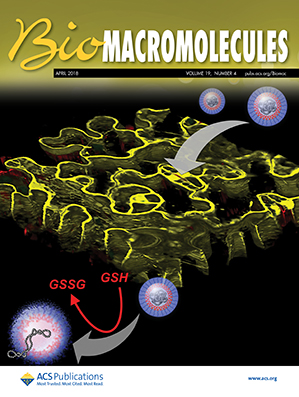In-Depth Investigation of Electrostatic Interaction-Based Hydrogel Shrinking for Volumetric Printing and Tissue Engineering Applications
IF 5.4
2区 化学
Q1 BIOCHEMISTRY & MOLECULAR BIOLOGY
引用次数: 0
Abstract
Three-dimensional printing of hydrogels enables the fabrication of complex structures for tissue engineering. Postprinting shrinking via electrostatic interactions offers a promising strategy to better replicate the size and intricacy of native tissues. This study explores hyaluronic acid (HA)-based hydrogels that undergo shrinking upon polycation penetration and complexation focusing on the influence of the HA macromer concentration, molecular weight, cross-linking density, hydrogel initial volume, and polycation properties on shrinking efficiency. To support cell adhesion, RGD peptides were incorporated into the HA network. The polycation concentration strongly affected cell viability: a high concentration of 1 wt % resulted in reduced viability, while 0.1 wt % preserved it with effective shrinkage. Volumetrically printed structures were reduced up to 9 times in volume, achieving features as small as 42 ± 6 μm. This shrinking approach enables the fabrication of hydrogel structures with significantly reduced dimensions, making it a powerful tool for developing high-precision hydrogel structures for tissue engineering.
- Download: Download high-res image (127KB)
- Download: Download full-size image
基于静电相互作用的水凝胶收缩在体积打印和组织工程应用中的深入研究。
水凝胶的三维打印使组织工程复杂结构的制造成为可能。印后收缩通过静电相互作用提供了一个有前途的策略,以更好地复制的大小和复杂的天然组织。本研究探讨了透明质酸(HA)基水凝胶在聚阳离子渗透和络合过程中发生收缩,重点研究了HA大分子浓度、分子量、交联密度、水凝胶初始体积和聚阳离子性质对收缩效率的影响。为了支持细胞粘附,RGD肽被纳入HA网络。多阳离子浓度强烈影响细胞活力:1 wt %的高浓度导致细胞活力降低,而0.1 wt %的浓度则有效地保留了细胞活力。体积打印结构的体积减少了9倍,实现了小至42±6 μm的特征。这种收缩方法使得水凝胶结构的制造具有显着缩小的尺寸,使其成为开发用于组织工程的高精度水凝胶结构的有力工具。
本文章由计算机程序翻译,如有差异,请以英文原文为准。
求助全文
约1分钟内获得全文
求助全文
来源期刊

Biomacromolecules
化学-高分子科学
CiteScore
10.60
自引率
4.80%
发文量
417
审稿时长
1.6 months
期刊介绍:
Biomacromolecules is a leading forum for the dissemination of cutting-edge research at the interface of polymer science and biology. Submissions to Biomacromolecules should contain strong elements of innovation in terms of macromolecular design, synthesis and characterization, or in the application of polymer materials to biology and medicine.
Topics covered by Biomacromolecules include, but are not exclusively limited to: sustainable polymers, polymers based on natural and renewable resources, degradable polymers, polymer conjugates, polymeric drugs, polymers in biocatalysis, biomacromolecular assembly, biomimetic polymers, polymer-biomineral hybrids, biomimetic-polymer processing, polymer recycling, bioactive polymer surfaces, original polymer design for biomedical applications such as immunotherapy, drug delivery, gene delivery, antimicrobial applications, diagnostic imaging and biosensing, polymers in tissue engineering and regenerative medicine, polymeric scaffolds and hydrogels for cell culture and delivery.
 求助内容:
求助内容: 应助结果提醒方式:
应助结果提醒方式:


